 It is implied that wars in which modern Japan fought against foreign countries—such as the Sino-Japanese War, the Russo-Japanese War, the Second Sino-Japanese War, and the Pacific War—have greatly impacted our current lives as well as the international environment. How can we get a real sense of such wars with the passage of over 60 years since the culmination of the Pacific War?
It is implied that wars in which modern Japan fought against foreign countries—such as the Sino-Japanese War, the Russo-Japanese War, the Second Sino-Japanese War, and the Pacific War—have greatly impacted our current lives as well as the international environment. How can we get a real sense of such wars with the passage of over 60 years since the culmination of the Pacific War?
Naturally, wars are the worst and the most extreme circumstances of human design. It is probably impossible to completely “know” and “learn” about such circumstances. The only thing that we can do is to continue the attempt to comprehend war by exploring a miniscule aspect of the war, by exploiting the various records that have been maintained from the past to the present—such records are referred to, in technical terms, as “historical records/archives.”
Since my days at graduate school, I have conducted research on various issues related to wars and the military. In my studies at undergraduate and master’s levels, I explored about who guaranteed the lives of the soldiers on the battlefield. After beginning my career, I attempted to relive the war, albeit only to a limited extent, by reading the diaries kept by the soldiers during their time in the army. During this period, I came across, and became enthralled by, the dubious nature of an historical archive known as propaganda fliers circulated during war-time in an effort to make enemies lose their will to fight.
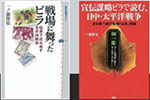
Associate Professor, Ph.D. (Comparative Social Culture) (Kyushu University, 2003)
Philosophy and History Course, Department of Liberal Arts, Faculty of Liberal Arts
January 19, 1971/Capricorn
During the Pacific War, both the Japanese and American armies printed a large volume of propaganda leaflets to drop above their opponents from airplanes, urging them to surrender.
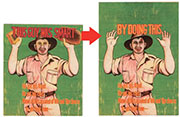 These were leaflets created by the Imperial Japanese Army General Staff Office at the beginning of the war. The man depicted on the left is an Allied soldier who has surrendered and holds a cigarette and food with the headline, “This guy was smart.” There is a gimmick attached to this leaflet; turning over the top section reveals the man holding his two hands up, encouraging the Americans to “do this” to surrender.
These were leaflets created by the Imperial Japanese Army General Staff Office at the beginning of the war. The man depicted on the left is an Allied soldier who has surrendered and holds a cigarette and food with the headline, “This guy was smart.” There is a gimmick attached to this leaflet; turning over the top section reveals the man holding his two hands up, encouraging the Americans to “do this” to surrender.
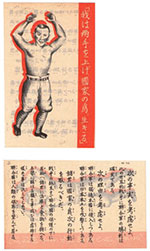 These leaflets asked soldiers to surrender with their shirts off, as the Americans were cautious of Japanese soldiers pretending to surrender only to use bombs concealed on their bodies to blow themselves up along with the American soldiers. Furthermore, the men illustrated are wearing jika-tabi (rubber-soled socks) because Japanese soldiers were forced to engage in clandestine nighttime attacks as the situation in the war was turning worse for the Japanese (the American army had been properly observant). However, complaints lodged against this leaflet within the American army claimed that the man was drawn to resemble a monkey and would antagonize the Japanese soldiers. Indeed, it reveals the racial prejudice of the artist. As such, a single leaflet can present the viewer with a glimpse into the real conditions of the war, such as the harshness of war fields and prejudice toward the enemies.
These leaflets asked soldiers to surrender with their shirts off, as the Americans were cautious of Japanese soldiers pretending to surrender only to use bombs concealed on their bodies to blow themselves up along with the American soldiers. Furthermore, the men illustrated are wearing jika-tabi (rubber-soled socks) because Japanese soldiers were forced to engage in clandestine nighttime attacks as the situation in the war was turning worse for the Japanese (the American army had been properly observant). However, complaints lodged against this leaflet within the American army claimed that the man was drawn to resemble a monkey and would antagonize the Japanese soldiers. Indeed, it reveals the racial prejudice of the artist. As such, a single leaflet can present the viewer with a glimpse into the real conditions of the war, such as the harshness of war fields and prejudice toward the enemies.
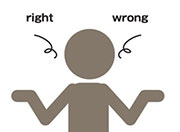
The flier lists the names of Japanese cities, including “Urawa,” and states on the back that these cities would be raided and that the citizens should evacuate (Fig. 1). However, the American army did not distribute these fliers based on humanitarian spirit, focusing on the citizens’ lives. Their intention was to purely cause confusion among Japanese citizens and lower the productivity of military factories. This can be gleaned from the flier in (Fig. 2), which was also disseminated by the American army. It depicts civilians wounded from bombs and aims to incite fear. With the damage to civilians already factored in, the back of the leaflet states that, “Although the American army’s bombs aim for the military and industrial targets, due to the bombs being very powerful, residents in the vicinity will also be impacted.” This could be seen as a form of defiance on the part of the Americans.
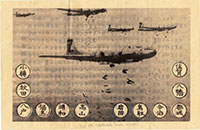
Fig. 1: Air raid warning flier made
by the American army
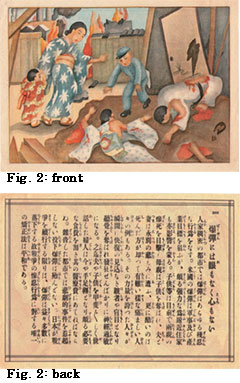


© Copyright Saitama University, All Rights Reserved.